12 interactive web design features to engage and convert visitors
 Igor and Dino, site reliability engineers
Igor and Dino, site reliability engineers
People love Disneyland because it transports you into a magical world where you’re the main character. It’s a totally different experience from passively watching movies.
You can take a page from Disney's playbook when creating your website by building stronger connections through a more immersive, interactive experience.
This article will explore 12 interactive web design features you can use, including quizzes, surveys and calculators built with AI. We’ll also highlight examples of these elements in action, and show how to implement the ideas on your MailerLite website and landing pages.
1. Quizzes
Quizzes are a fun way for website visitors to interact with your brand. Embed the quiz on your website and let people take part by answering questions.
You can use quizzes in many ways, for example:
Run competitions: Offer to send a prize to people who get all the questions correct
Learn about product preferences: Ask people to choose between multiple products
Recommend products: Use the quiz answers to provide personalized recommendations
The best thing about quizzes is that they can attract newsletter subscribers, which is useful for your e-commerce email marketing efforts.
To make it work, add a signup form step to the quiz to encourage participants to register for your newsletter. If someone signs up, you can send content to bring these people closer to your brand.
Cosmetics store Spongelle’s quiz is a great example.
The quiz helps customers choose a product. Before showing the results, the company offers to send participants a 25% off voucher if they sign up for the email list.
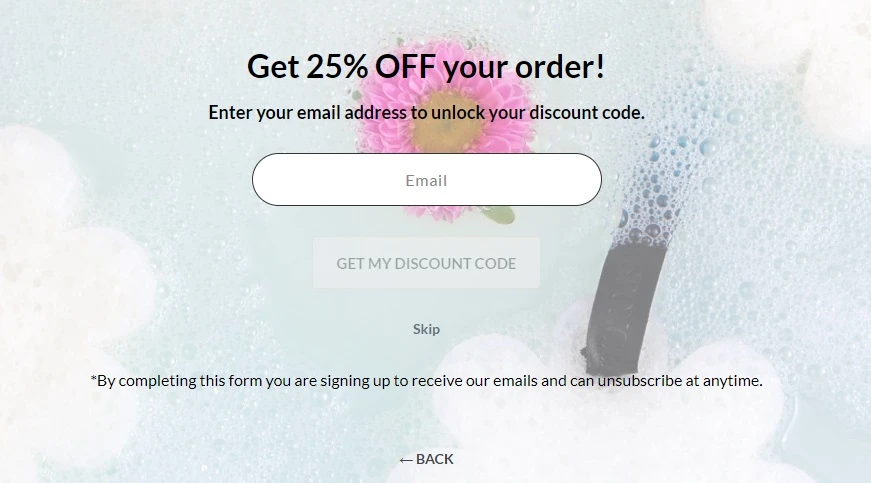
You can easily use MailerLite to build interactive quizzes with multiple question types.
Just select the quiz block in the website builder and then choose the questions you want customers to answer. Then add a signup form to collect email addresses.
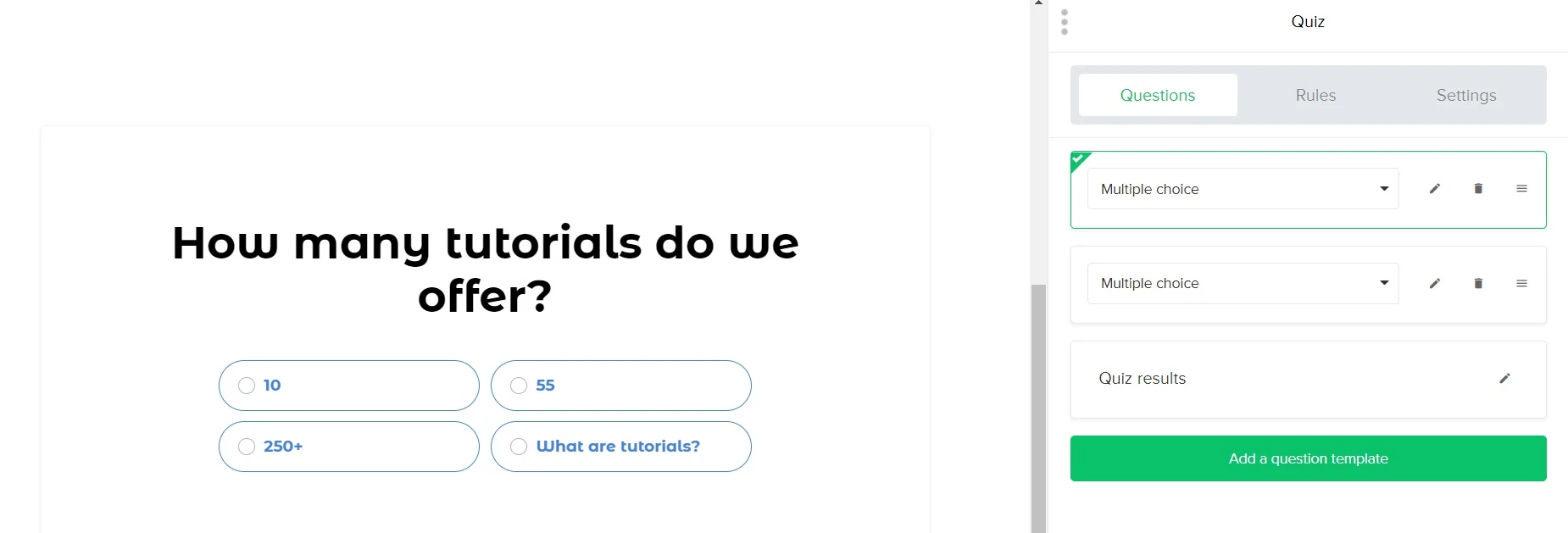
2. Spin the wheel pop-ups
A spin-the-wheel pop-up is an interactive website feature that lets visitors spin a virtual raffle wheel for the chance to win a prize.
Visitors enter their email addresses to receive the gift, making it a good way to increase interaction and generate email signups. These pop-ups can even boost sales, since the right prize—such as a discount—can encourage people to buy.
You can easily add a spin-the-wheel pop-up to your website by designing the pop-up and then adding it to your MailerLite website. Or you can use our integrations to add it to WordPress or your e-commerce store.
Start by choosing one of our spin-the-wheel pop-up templates, deciding which prizes to offer, and then assigning each segment of the wheel a percentage chance of winning. Once finished, use the settings to decide when to show the pop-up and on which website pages.
Browse all the available pop-up templates below and then click on one to start building.
3. Teaser pop-ups
Teaser pop-ups appear at the side of the browser window when the visitor opens a relevant page.
The person can interact with the pop-up by clicking the message, causing it to open over the website content. When they close the pop-up, it goes back to the side of the page. This boosts the visibility of your offer without being as disruptive as a regular pop-up.
MailerLite customers can create a teaser pop-up by building a regular pop-up and then checking the option to add a teaser.
You can then customize the teaser settings by changing its position, text and colors. You can also choose whether to show the teaser pop-up at all times, or only before or after showing the main pop-up.
See how it looks in the GIF below!
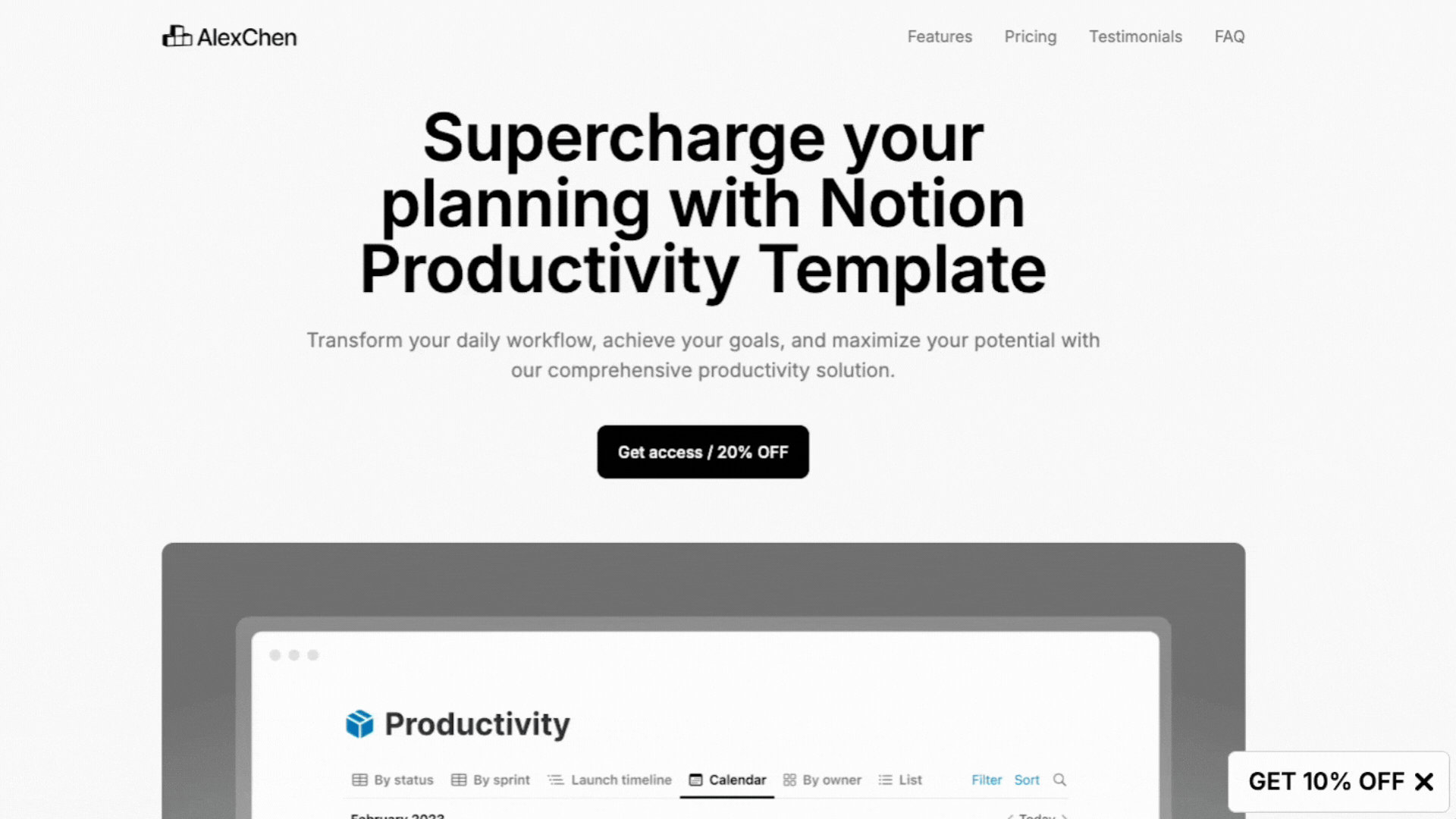
Build an interactive website with MailerLite
MailerLite’s visual landing page and website builders have all the tools you need to create interactive experiences, even if you can’t code. Plus, you can access features like a blog, A/B testing, and (of course) advanced email marketing tools. Try it today!
4. Surveys and forms
Surveys are interactive elements that help you learn about your site visitors. Use this knowledge to optimize your website user experience.
You can discover what customers think about:
Your products
Your website experience
The checkout process
Your tutorials and learning materials
The quality of customer service interactions
Whether they are likely to recommend your brand
This knowledge helps you tailor your website toward your customers' needs.
The MailerLite survey feature is an easy way to add surveys to your website. You can create your own questions in formats like multiple-choice, images or text.
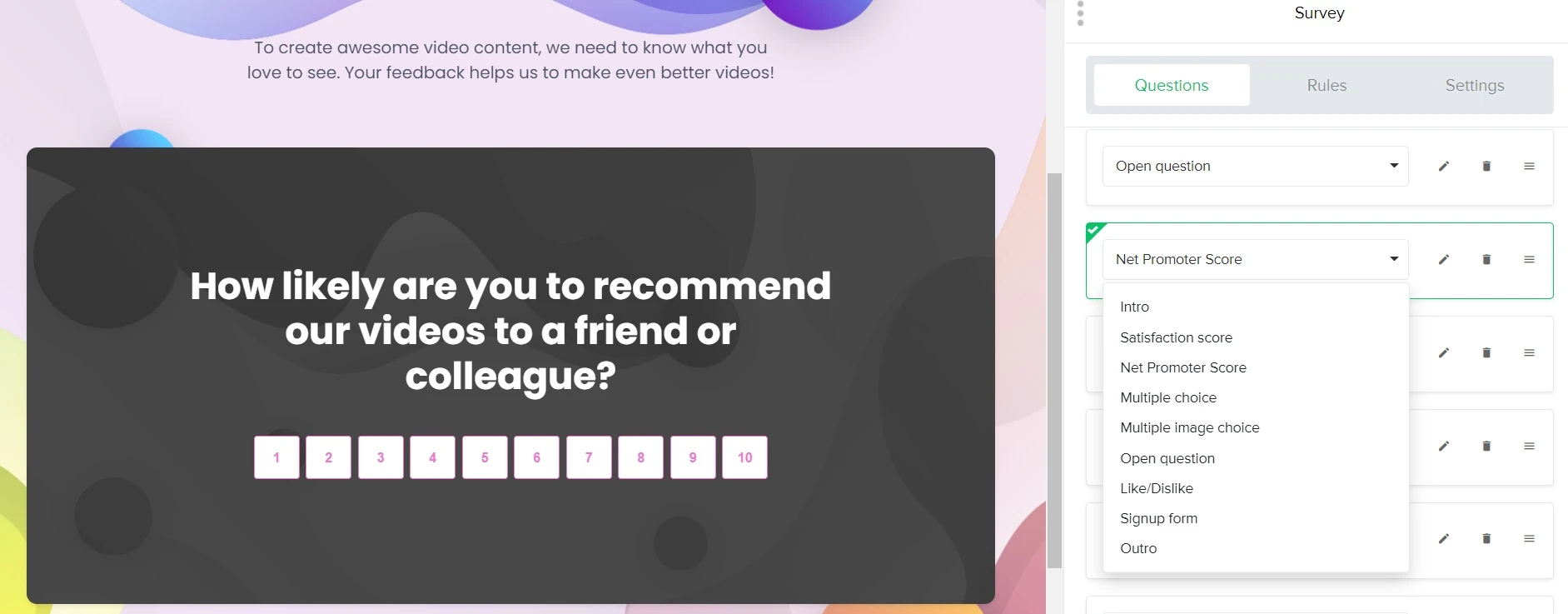
You can also use templates for common surveys like Net Promoter Score (NPS) and customer satisfaction (CSAT). These are surveys designed to yield data about the quality of your customer experience (CSAT) or whether customers are happy to recommend your brand (NPS).
People like short surveys. Limit yours to the most important questions so people who start a survey are likely to finish it.
You can add surveys to any page on your website. Or you can create specific pages with your survey. Increase the number of people who see them by adding promotional pop-ups to your website that direct visitors to the relevant page.
And while surveys are a great way to encourage website interaction, you can also use them in other customer interactions.
For example, you can add surveys to your email newsletter. Or you can use a transactional messaging tool like MailerSend to automatically send surveys to customers after every purchase or service interaction.
5. Problem-solving calculators
Interactive calculators are helpful tools that your website visitors can use to quickly solve their problems.
Here are some examples:
A SaaS tool could create an ROI calculator
A financial service could create investment calculators
A real estate firm could create a housing costs calculator
A service provider could create a custom quote calculator
Until recently, you needed to know how to code to create one of these tools. Now, anyone can create one with AI. Just ask the AI tool you use to write the code and then embed it on your MailerLite website or landing page using the code block.
See an example below. We created the two calculators in literally minutes by telling the AI tool (we used ChatGPT) what we wanted and asking it to write the code. Then we pasted the code into a MailerLite landing page HTML code block and adjusted the styling.
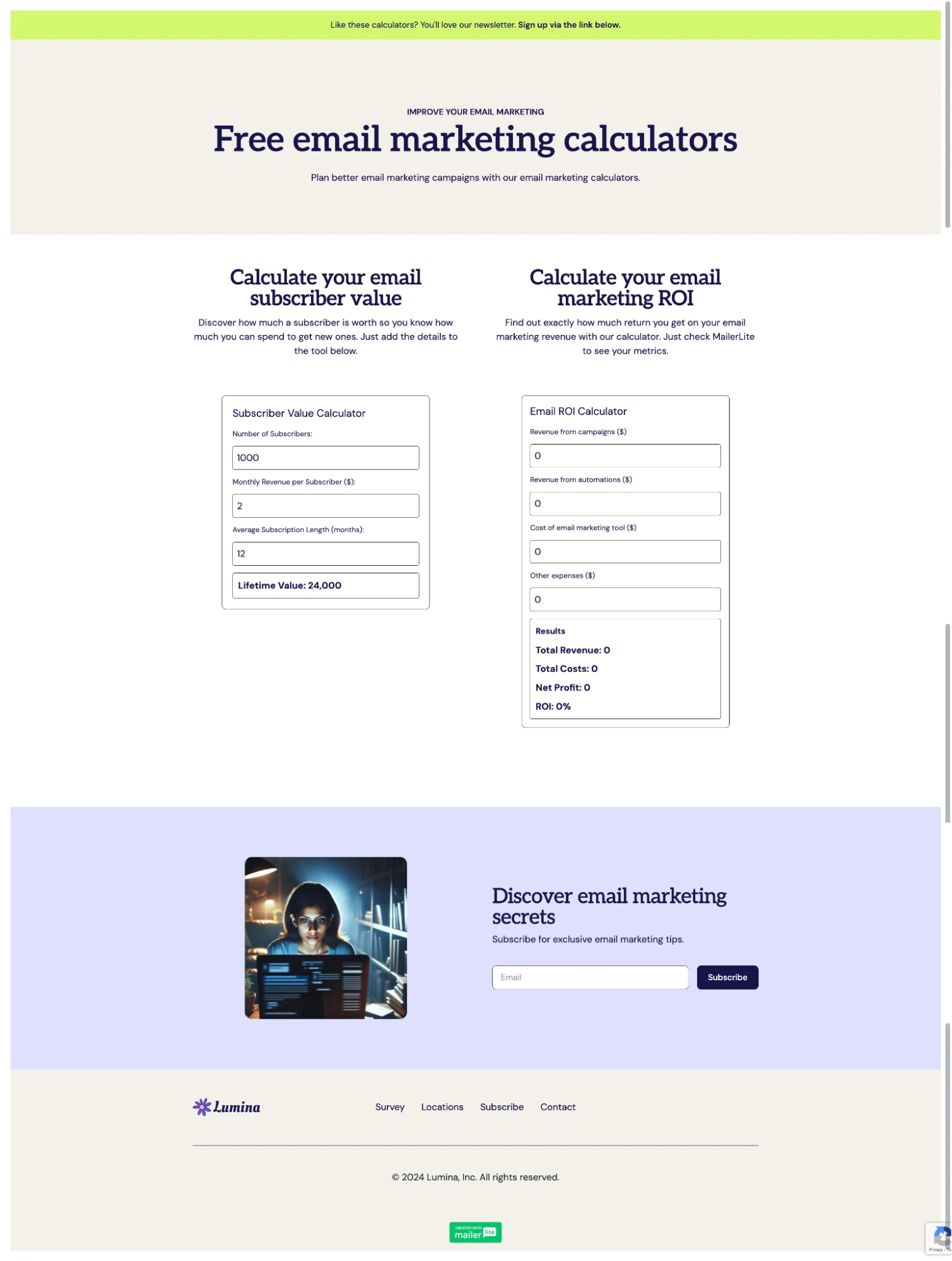
Here are some tips that will help you create useful calculators:
Choose calculators that will appeal to your ideal customers
Keep them simple! The more complex the calculator, the more complex the code, which can cause problems for the AI tool
If something doesn’t work, try asking the AI to fix the code for you
Add the code block to its own column so you have more control over how it fits in with the other content on the page
Experiment with the section settings to get a design you like. You can adjust alignment, spacing, and more
Also, remember that custom code doesn’t work in the landing page preview mode; you have to publish the page to test it properly.
6. Searchable directories
Directories are filterable lists that you can add to your website. They’re a great way to organize information and make it easy for your website visitors to find what they’re looking for.
To add a directory to a MailerLite website, you first need to create the directory in a third-party tool and then embed it on your website or landing page. We did this to create the directory of email marketing automation ideas you can see below.
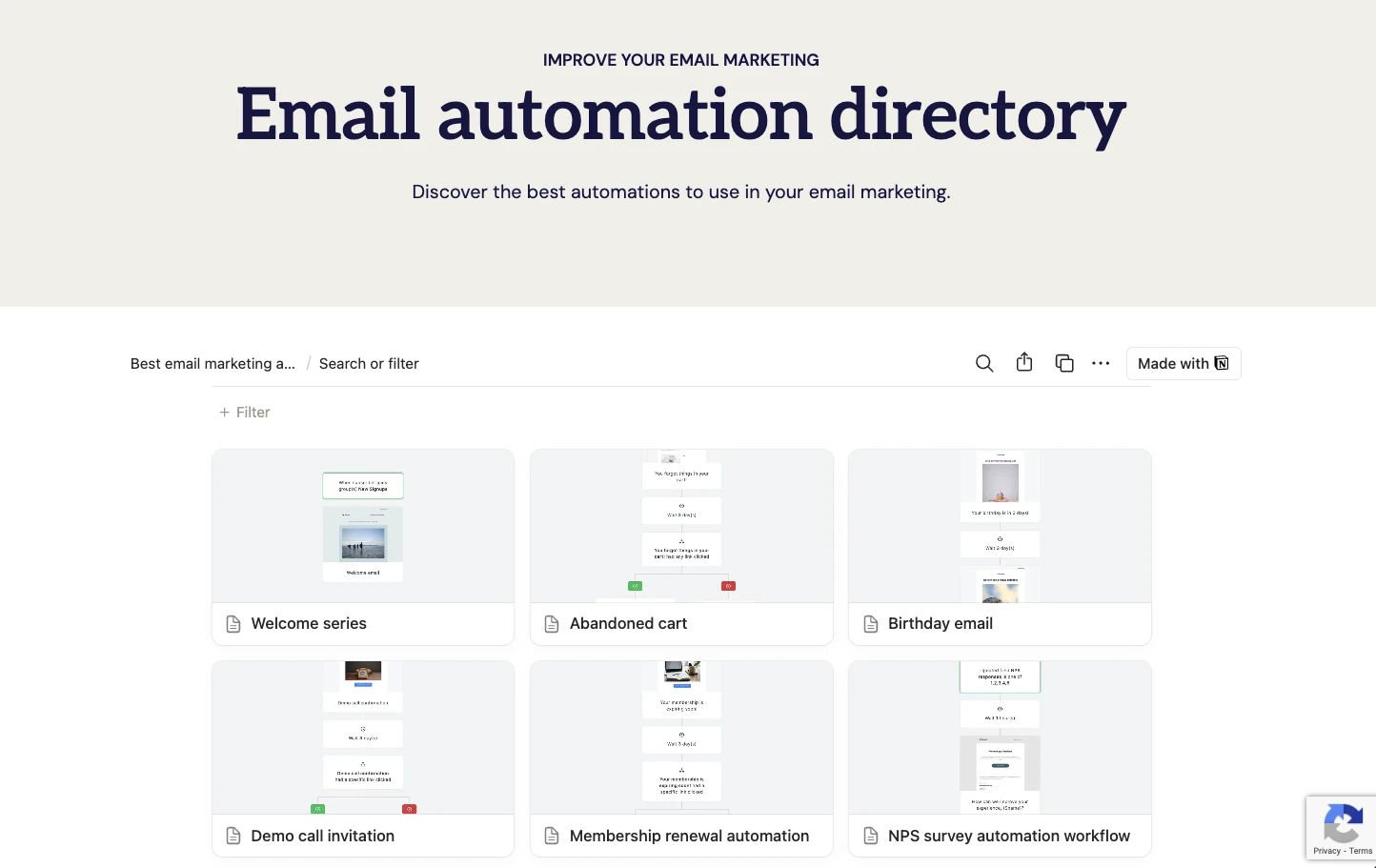
Notion makes creating directories easy, and it has a handy embed option, so it's the tool we used for our example. Plus, you can use it for free!
Start by creating a database in Notion and then adding the fields you need. You can then create categories that people can use to filter the results and assign these to each entry. Discover more about creating a database in Notion in the tool’s official guide.
Once you’ve created the directory, you need to publish it to a live Notion website. You can then paste the embed code and add it to your MailerLite website with the code block.
Asking people for their email address to access your directory is a great way to grow your list. 100 Days of No Code created a list of no-code tools, which they asked people to provide an email address to access. They gained over 3,000 subscribers in 10 days!
Gate access to your directory by creating a landing page that highlights its benefits and tells people they can access it by entering their email address. You can then embed the directory on the landing page’s success page.
7. Videos and image galleries
Videos and image galleries are an easy way to make your website more interactive. Adding a video to your website or homepage is easy—just grab the embed code from the video hosting site and paste it into your page. You can use your own content or even videos produced by someone else.
If the video is on YouTube, just follow these steps
Head to the video you want to upload.
Click share.
Click embed.
Copy the HTML code.
Paste it into your website where you want the video to appear.
Image galleries are another interactive form of visual media. Website visitors click on the gallery to view the photos on your webpage. They can then click through to view each picture in more detail.
You can use this feature to showcase high-definition images of your products. This helps people gain the information they need to buy.
Image galleries are practically essential if you sell visual products like clothes, art, or furniture. You can see how H&M uses image galleries in the image below.

You can also use them in blog posts to showcase further information about the topic you are writing about.
Testimonials and review sliders help website owners present these customer opinions interactively. Visitors can scroll through the reviews to find ones relevant to them.
You can then add all the images you want to include and configure their appearance.
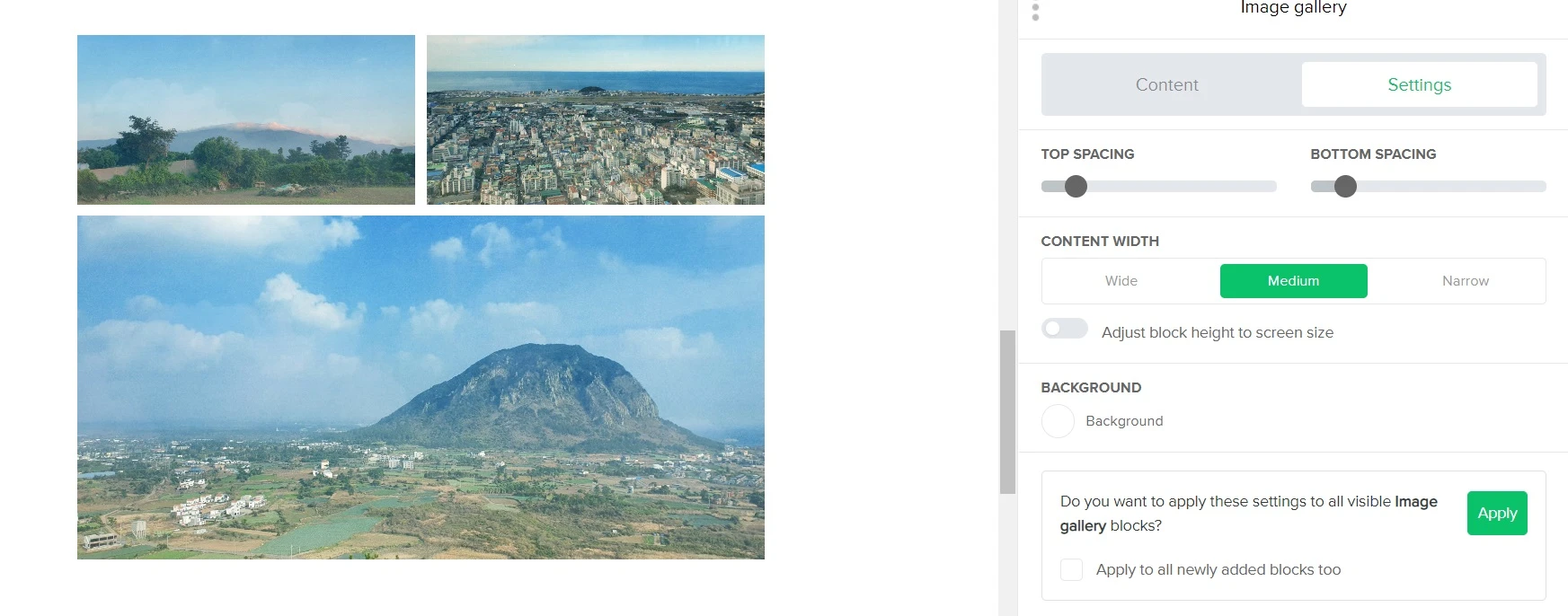
Once it’s live, visitors can view your images in a grid or click on each one to view it full size.
Then try an image carousel. These let you showcase multiple images in the same space as a single image. Website visitors just scroll through each of the photos.
8. Reviews and testimonials
Adding social proof to your website is an effective way to build brand trust. It works because people who visit your website see how your product has impacted real people.
Testimonials and reviews help website owners present these customer opinions interactively.
Reviews work because they show the visitor how other people experience your product. They also answer common customer questions.
Testimonials can be just as effective. Add these to product landing pages to showcase how your product has benefited customers.
Shoe brand Allbirds has an excellent interactive review feature. Each product page has a search bar that website visitors can use to find reviews about the product they are interested in.
The reviews provide detailed information about what customers think about the shoe’s fit, quality, and style.
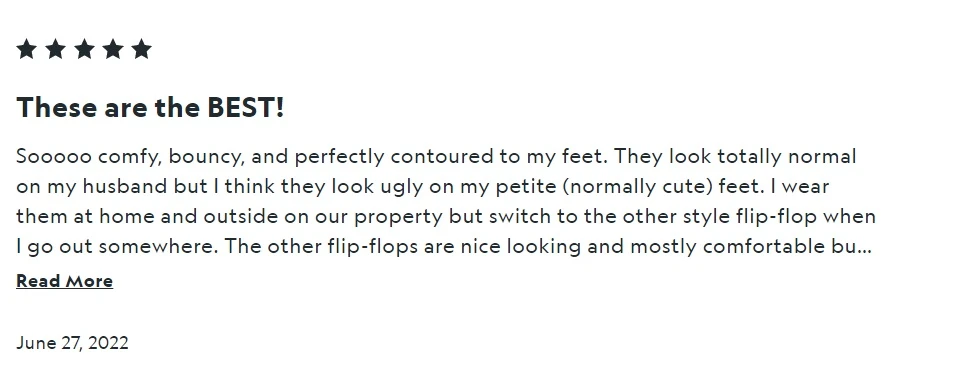
9. Maps
Maps are a useful feature if your business has a physical location.
Customers can see exactly where you are based by interacting with the map. They can also click on your Google Maps business profile to get directions or discover company information. This makes it easier for people to find your business and buy from you.
Adding maps to a website is straightforward thanks to the Google Maps embed feature.
Just follow these instructions:
Search for your business on Google Maps.
Open your Google Maps profile and click Share.
Open the “embed a map” tab and copy the HTML.
Add this code to your website where you want it to appear.
You can see how this looks in an example for the Nike Town in London below.
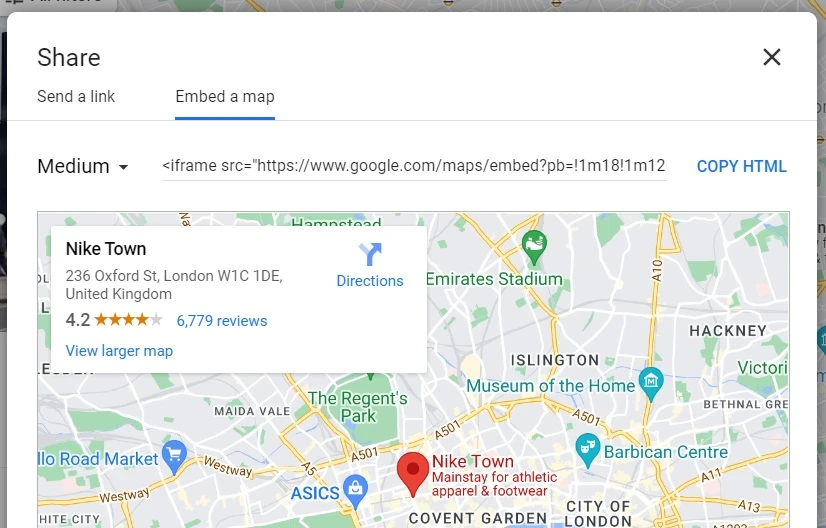
MailerLite customers can also add maps to their websites or pages using the map block.
Just drag the block to the place in your page where you want it to appear. Then highlight a location by adding an address.
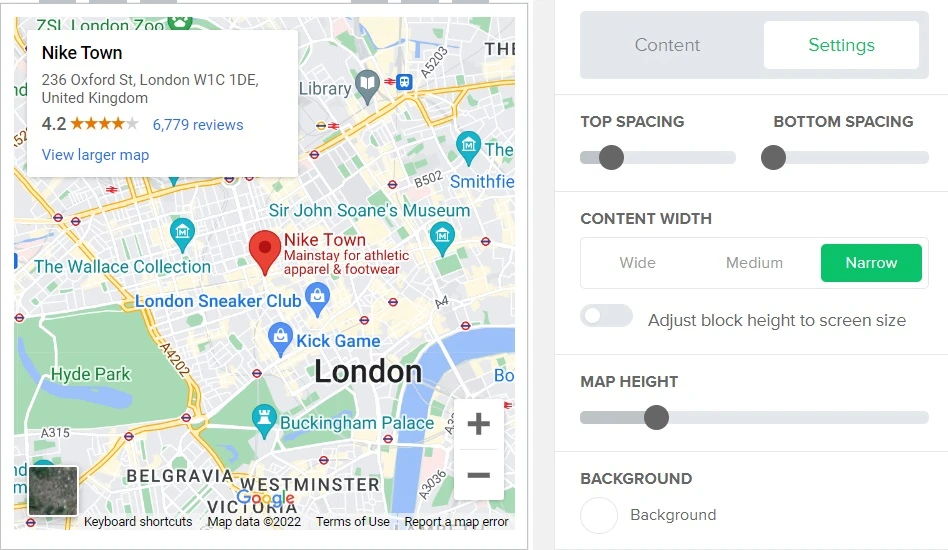
The benefit of using this block over embedding code is that the block has easy customization options. You can edit the map's spacing, background color and width. Use these features to get the map's design just as you like it.
10. FAQ accordion
Accordions are website content sections that let website visitors engage by clicking on questions to expand or collapse answers. This interactivity helps people navigate and find information efficiently while keeping the page organized and user-friendly.
They’re perfect for FAQs since they let you answer lots of questions without filling your page with a wall of text. But, they can be used for any kind of expandable content like step–by-step instructions, tables of contents or feature descriptions.
If you built your website or landing page with MailerLite, you can easily add an accordion by dragging in the relevant block, adding questions, and then adjusting the design settings.
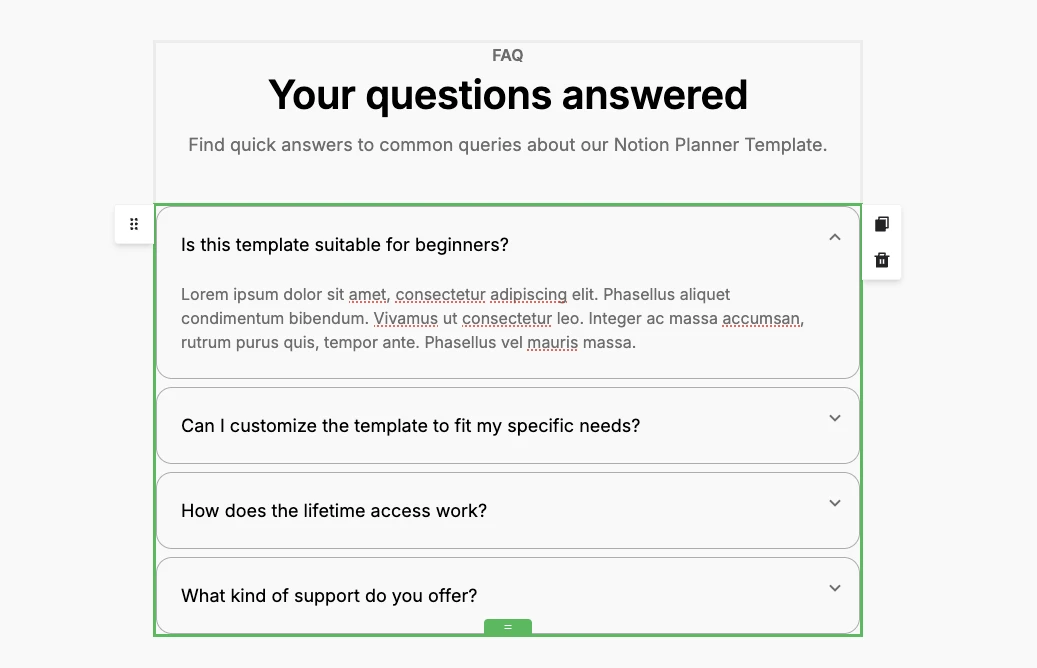
11. Live chat
Live chat widgets provide an incredibly interactive experience. And most tools allow you to customize the content in the widget based on the page it’s on.
They typically have features that let customers:
Connect to real-time live chat.
Communicate with a chatbot.
View blog posts or articles relevant to the page they are looking at.
Search through knowledge base articles.
This has several uses. Buyers can use it to connect with customer support during the buying process to find answers that may have stopped them from buying. For example, they can learn about payment options or product features.
Existing customers can use the tool to discover information about delivery or returns. Making this information easy to access can reduce the number of customer service tickets your team has to answer.
Most live chat tools make it easy to add their widgets to your website by pasting a code snippet into your website code.
You can easily do this with MailerLite websites and landing pages via the custom code injection setting. Just add the code to the header or page, depending on the instructions from the tool you use.
Warby Parker’s chat widget is a great example. It contains common questions potential customers may have about buying a new pair of prescription glasses.

12. Social media sharing and embeds
There are many ways to use social media to increase website interaction.
The simplest method is to add share buttons. With these in place, visitors who enjoy your content can share it with a single click.
Maximize the impact of this by optimizing the social share settings for each of your pages. This lets you choose exactly how your content appears when shown on social media.
You can customize the:
Title: Write a title that is likely to stand out on social channels
Image: Choose which image shows on social media and ensure it is the optimal size
Page description: Write a description that makes people want to click on your page
Adding this information is vital because when social networks pull content from your page to add the link, they don’t always choose the best content for the job. For example, the description might be too long, or they may choose the wrong image.
With MailerLite, you have the option to optimize this content whenever you publish a page with our landing page or website builder. This makes it easy to configure this information without using code.

Another way to add social media interaction is to embed posts into your website content.
This is easy to do by copying the embed code from the post and then embedding it into your website in the appropriate place.

People can then click on the social media post to share or comment on it. There are several ways to use this type of content.
Embedding content from your own social media channels can turn website visitors into social media followers.
Embedding content from your customers is social proof that highlights how people use your product.
We do this in our blog posts by embedding content from our Instagram channel. When we do this, we can provide a more interactive experience and boost the visibility of our other channels. The key is to find relevant content that adds to the content in the blog post. See an example below!

Interactive web design is easier than you think
Tools, plugins and website builders are a straightforward way to add interactive content to your website.
It’s often just a case of embedding content, adding a plugin or integration, or choosing from the existing elements in your chosen website builder.
For the next steps, consider the types of website interactivity that will benefit your visitors and help you reach your goals.
You can then start to research and use tools that enable this kind of functionality.
Build an interactive website
Sign up for MailerLite to access our interactive website features. Add them to your existing website, or create a new site with our website builder. Try all our premium features for free for 14 days.
Editor's note: This post was originally published in August 2020, but has been updated with new examples of interactive website features.

Travis Jamison has been involved with e-commerce for over a decade. As the Founding Director of Smash.VC, he is an investor and strategic growth partner in a number of bootstrapped e-commerce ventures.

